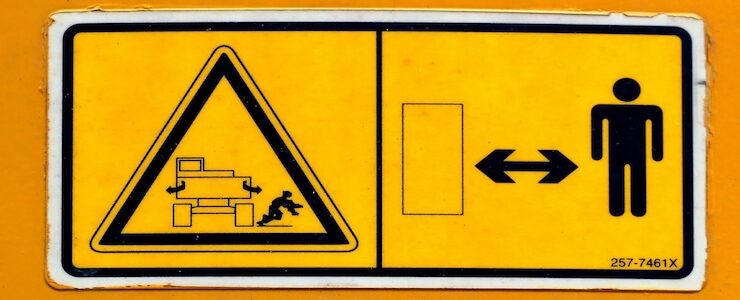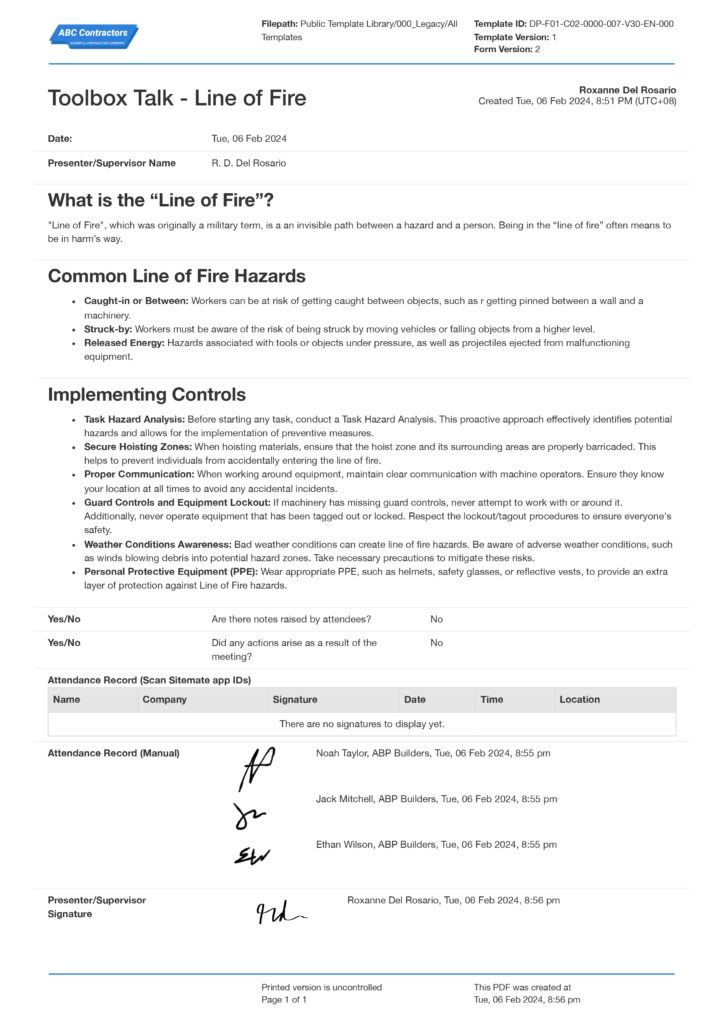Dashpivot Article – What is Line of Fire in the Workplace?
What is Line of Fire in the Workplace?
In this article, we will answer the question what is line of fire in the workplace so that you can equip your teams with an understanding of what constitutes a potentially dangerous situation.

What is Line of Fire in the Workplace?
You have probably heard of “Line of Fire” in a different context like in the military, and you’re right! “Line of Fire” is originally a military term. It basically means that when someone is shooting at a target and you are in the way of the trajectory – the line of fire – you could get hurt. In the workplace, it’s similar in that you could get hurt, but the work situation you are in causes you to put yourself or others in harm’s way. A specific example of this is if an individual’s body is positioned close to the area of a moving object, which can happen in any workplace. In this article, we are going to answer the question what is line of fire in the workplace, as well as provide a number of examples for you to better understand the concept.
Not all workers are conscious about the line of fires in the workplace; recent workplace accidents worldwide are due to the lack of awareness of the line of fire. This can be due to a lack of training, familiarity with the job leading to complacency, ignoring safety protocols, the lack of proper safety standards in the workplace and worker’s general complacency while on the job.
Line of Fire Examples
Line of fire example one (1) In the pathway or underneath a moving equipment
Whether you are in a production factory or a construction site, the heavy machinery and earthmovers are taking over the job of lifting, moving, and digging loads of materials across locations. These machines have saved loads of time and finances in businesses but are also one of the major hazards in the workplace. Examples of the line of fire in this moving equipment are: if an operator is walking beneath a crane’s lifted load and can get struck when the load swings, if a worker is in the area of the swinging trajectory of crane and it suddenly swings, when a worker who is anywhere near an excavator’s bucket is struck by a forced contact and when a worker is standing beside the excavator and it accidentally topples.
Example two (2) - Release of Potential Energy
This covers the potential energy pent up in and is suddenly released from machineries, pipelines or electrical sources. This is one of the most dangerous accidents as it often results in fatalities. The release of potential energy in electricity can put people in the line of fire by electrical shock i.e when a worker touches a live wire, causing a shock to their body and causing burn. Mechanical stored energy releases that are found in ropes, springs, cables that are stretch very tight that if it would break or snap it could put the people within the path in the line of fire. The line of fire in the stored energy in the pipelines are when these pipelines burst in an area that could cause burn, or a sudden release of pressure.
Example three (3) - Avoiding safety protocols when using tools and operating rotating equipments
The majority of workplace incidents are due to unsafe behaviour and this is not because safety protocols are not present but because it is ignored. The proper and safe use of tools and rotating equipments in manufacturing for example are often overlooked. Despite the obvious danger, the highest proportion of injuries are injuries to fingers (cuts, lacerations, and the worst one, amputated). This because of bypassing while the machine is in operation. Operators put themselves in the line of fire when they place any part of their body or clothing near a machine, especially when attempting to clear a jam while the machine is still in operation.
Strategies on How to Keep Yourself Safe in the Line of Fire
Locate the hazards and eliminate
The worst thing that could happen is to be unaware that you are in the line of fire and you cannot remove hazards that you cannot locate, so you need to identify hazards in the workplace first to eliminate them. If it cannot be eliminated, provide controls. For instance, you cannot completely eliminate the danger of lifting loads but you can make a demarcation mark in the floor to warn the workers that they are in the line of fire. These demarcation are the areas or hazard zone in the floor that when an individual is positioned, they could be fallen under.
When you create these demarcations, ask yourself as to where could the moving equipment accidentally fall or get caught in a person in the zone and how far it would hit? Use clear, visible safety signage and floor markings to detail these hazardous areas, such as those prone to struck-by incidents from a crane, backhoe or any moving equipment. Highlighting these zones helps in reminding workers to maintain a safe distance.
Identify the worst case scenario in each process and closely monitor if the current controls are effective in limiting the hazards.
Conduct customised Safety Training
Provide safety training tailored to the specific needs and risks of the workplace. This could include hands-on sessions focused on recognising line of fire hazards and identifying how to put yourself in risk. Training should be customised to check first the root cause of the previous incidents and how to eliminate the cause by training and have feedback from the workers as well. Make sure to use simulations or actual examples to demonstrate safe positioning when working near or with heavy machinery that could move unexpectedly and rotating machineries should not be be touched when still in motion. Explain each purpose of the Personal Protective Equipment and how it protects the body when operating.
Implement Safety Training with experienced workers
Some of us needs to see it to believe it, training in theory may not be easily grasp by those who are still fresh in the workforce. Have experienced operators share knowledge and experience with new operators. Experienced workers can provide guidance on navigating the unique safety challenges of the workplace and some can even share their personal experience in the near miss or accidents they or others they’ve witnessed have encountered. They can share best practices for working near moving equipment or the importance of spatial awareness in preventing struck-by incidents.
Utilise Job Safety Analysis (JSA)
A Job Safety Analysis (JSA) is a systematic procedure that sections each job step into training points, identifies potential hazard and recommended action or procedure. Implement JSA or similar methodologies to identify potential line of fire hazards associated with each tasks. For job steps involving the risk of caught-in or between moving equipment, being underneath a lifted load, working next to a machine in motion, or potential release of energy – a JSA can devise control measures such as machine guarding or the use of lockout/tag out procedures. You can use this JSA template to improve the structure of your JSAs, or streamline the end-to-end JSA process via a JSA App.
Adopt Technological Solutions in the workplace
Adopt advanced technology solutions, such as proximity sensors in machines and wearable devices, that alert workers when they approach danger zones or when machinery is activated. For instance, using RFID tags to enforce exclusion zones around equipment that could cause caught-in or between incidents. Upgrade your machines to have touch sensors that halts the operation when it detects physical contact.
Emergency Response Drills
Regularly conduct emergency response drills that simulate emergency situations involving line of fire hazards. These drills can help workers practice their response to incidents, such as a sudden release of stored energy, ensuring that they are prepared to act swiftly and safely in real scenarios. It can also identify if the response plan is enough given the simulated reaction of the workers involved.
Ensure that you document any strategies that you implement. Line of fire hazards will change depending on work activities and the current state of the workplace so you will have to continuously improve your strategies in order to keep your workplace safe.
Hold a Toolbox Talk in the line of fire hazards
Toolbox talk is a safety meeting that could be very effective in discussing with the team the line of fire hazards that were discovered as well as the controls implemented to avoid it.

Use and customise this line of fire example toolbox form
Educate your team about what line of fire hazards are in the workplace with custom toolbox talk forms
Line of fire hazards are a widespread and recurring danger that warrants regular toolbox talks. You will have to alter the content of the talk to reflect the type of line of fire hazard and the source. This is Consider using this customisable Toolbox Talk form in Dashpivot. It details the line of hazards common in a workplace, controls and avenue to hold a discussion for the safety of the workplace.
With this form, you can outline the dangers of line of fire hazards, identify existing hazards in the workplace, and inform your team of existing hazard controls. You can also note additional hazards raised by team members, assign action items, and record meeting attendance by scanning using Sitemate App IDs.
In Summary
We learned what is the line of fire in the workplace, we covered examples of the line of fire which would help you in identifying if you and others are in harm’s way, we covered strategies to keep you and your workplace safe that involves training, learning from experienced workers, utilising JSA, adopting advance technologies and to hold a toolbox talk daily. We also discussed how Dashpivot forms can be created depending on your needs.

Toolbox Talk Pinch Points Template
Minimise the impact of pinch point incidents by following this toolbox talk

Demolition Job Hazard Analysis template
Demolition work can be dangerous if you're not managing the hazards with this Demolition JHA template.

Safe Work Method Statement for Mobile Plant template
Reduce mobile plant incidents and ensure everyone working on and around mobile plant is doing it safely.
